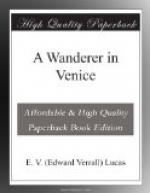[Illustration: THE PRESENTATION FROM THE PAINTING BY TINTORETTO In the Church of the Madonna dell’Orto]
The Madonna dell’Orto is not a church much resorted to by visitors, as it lies far from the beaten track, but one can always find some one to open it, and as likely as not the sacristan will be seated by the rampino at the landing steps, awaiting custom.
The church was built in the fourteenth century as a shrine for a figure of the Madonna, which was dug up in a garden that spread hereabout and at once performed a number of miracles. On the facade is a noble slab of porphyry, and here is S. Christopher with his precious burden. The campanile has a round top and flowers sprout from the masonry. Within, the chief glory is Tintoretto. His tomb is in the chapel to the right of the chancel, where hang, on the left, his scene of “The Worship of the Golden Calf,” and opposite it his “Last Judgment”.
The “Last Judgment” is one of his Michael-Angelesque works and also one of his earliest, before he was strong enough or successful enough (often synonymous states) to be wholly himself. But it was a great effort, and the rushing cataract is a fine and terrifying idea. “The Worship of the Golden Calf” is a work interesting not only as a dramatic scriptural scene full of thoughtful detail, but as containing a portrait of the painter and his wife. Tintoretto is the most prominent of the calf’s bearers; his Faustina is the woman in blue.
Two very different painters—the placid Cima and the serene Bellini—are to be seen here too, each happily represented. Cima has a sweet and gentle altar-piece depicting the Baptist and two saints, and Bellini’s “Madonna and Child” is rich and warm and human. Even the aged and very rickety sacristan—too tottering perhaps for any reader of the book to have the chance of seeing—was moved by Bellini. “Bellissima!” he said again and again, taking snuff the while.
The neighbouring church of S. Marziale is a gay little place famous for a “Tobias and the Angel” by Titian. This is a cheerful work. Tobias is a typical and very real Venetian boy, and his dog, a white and brown mongrel, also peculiarly credible. The chancel interrupts an “Annunciation,” by Tintoretto’s son, the angel being on one side and the Virgin on the other.




